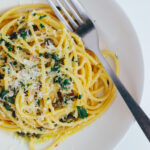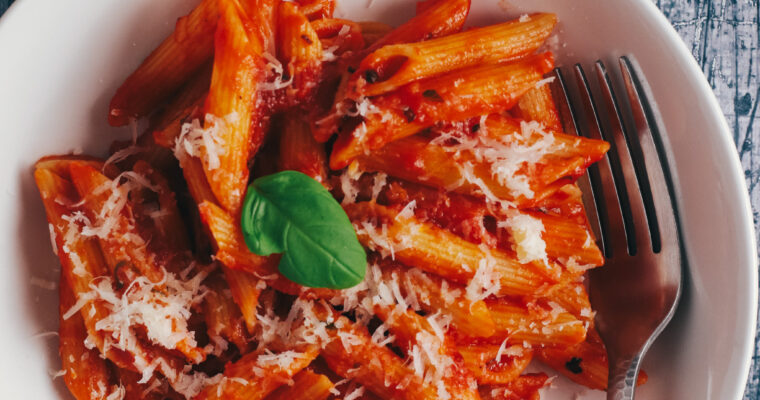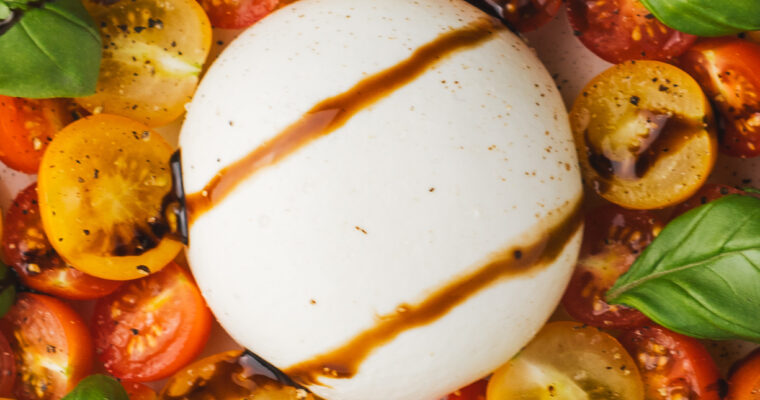Ready to experience the ultimate flavour adventure? Look no further than our tantalizing lemon caper pasta recipe! Brace yourself for an unforgettable rendezvous between tangy lemons, briny capers, and perfectly cooked pasta. It’s the perfect busy weeknight dinner…
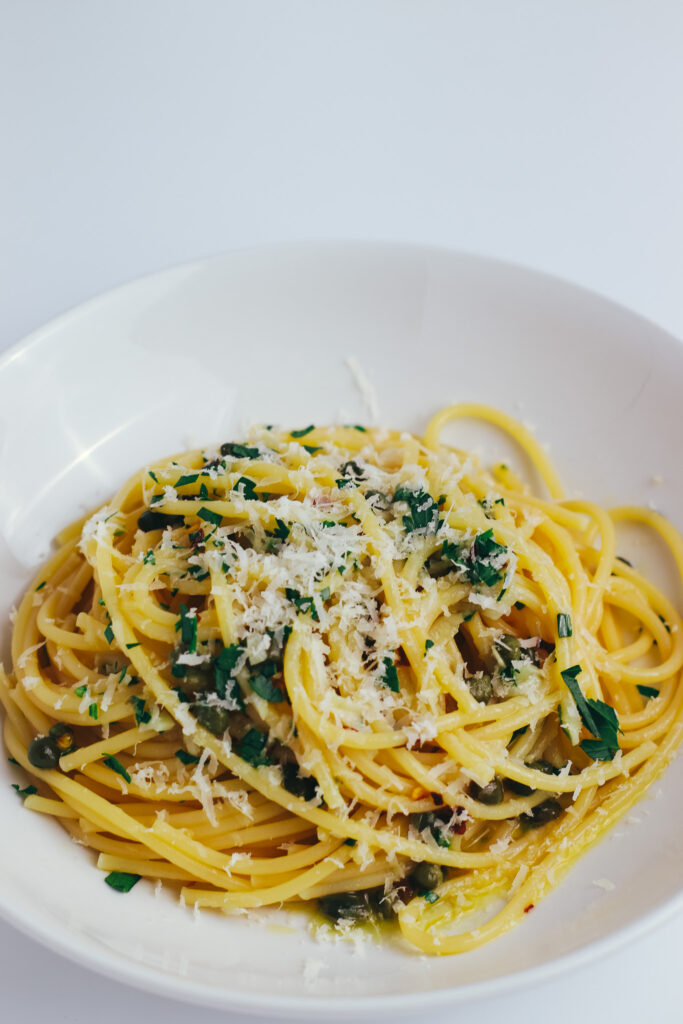
Why You Will Love This Recipe
- Super simple and packed with flavour
- Fresh, clean, and great on its own or as a side dish
- Super quick – great for a quick meal
- Use with your favourite pasta e.g. linguine, tagliatelle, spaghettone, bucatini
How To Use Capers
Capers are usually brined or packed in salt and ready to use straight from the jar without the need to cook. This versatile ingredient can be added cold to salads or cooked in your favourite pasta or Mediterranean style dishes. Drain them first if they are soaked in brine. Taste a caper. If you find them too salty and briny, you can always rinse them to remove any excess.
What Is Lemon Caper Sauce Made Of?
This creamy lemon caper pasta recipe is a super simple sauce made with just a handful of ingredients – olive oil, butter, capers, garlic and some pasta water to help bring it all together. It’s a quick weeknight dinner and can be ready in 15 minutes!
Ingredients
To make this delicious one pan pasta with lemon and capers you only need simple ingredients and one magic ingredient – pasta water!
- Spaghetti – I have used spaghetti for this recipe. Most people are familiar with this or have this in their cupboards but you could use any pasta you have.
- Capers – there are different varieties of capers but I like the small nonpareille variety. They are smaller and I use ones that are packed in salt rather than brined. You can rinse off the extra salt or brine if needed.
- Extra virgin olive oil – use a good quality extra virgin olive oil as this forms the base of the sauce.
- Unsalted butter – I like to add butter to the olive oil to make the resulting sauce a little more luscious and creamier
- Fresh Lemon Juice – lemon juice adds some nice zing and freshness to the dish. Fresh lemon is a must along with lemon zest
- Chilli flakes – red pepper flakes provide a nice little bit of heat at the back of the dish. You can also use fresh chillis if you prefer.
- Fresh Herbs – some fresh chopped fresh parsley adds to the freshness of this dish
- Parmesan – I like a good sprinkling of parmesan cheese on my pasta dishes. If you don’t have it you can do without but you could also use grana padano or even pecorino.
- Cup pasta water – the starch in the pasta water helps to emulsify and thicken to create a sauce for the pasta

How To Make Lemon Caper Pasta
- Begin by getting your pasta cooking. Use a large pot of water and don’t forget to salt it well. I usually just add a large handful to make sure the pasta gets seasoned well.
- We want to cook the pasta until al dente, so 1 minute before fully cooked (according to package instructions), remove and drain, reserving some of the pasta water for the sauce. This helps to emulsify with the olive oil and create that silky sauce.
- As the pasta cooks and a few minutes before fully cooked, melt butter and olive oil over medium heat and saute the minced cloves of garlic for a minute or so in a large skillet, then add the chilli flakes and capers for another 30 seconds of cooking
- Now add some pasta water and then add the drained pasta, tossing frequently. It is this tossing action (and starchy water) that helps to thicken and make a creamy sauce without adding any heavy cream. Toss the pasta over medium-low heat.
- Add the lemon juice and parsley and toss again to combine. If the pasta is dry, you can always add more pasta water.
- Plate and finish with some grated parmesan cheese, black pepper and lemon zest
Cooking The Pasta
Cooking pasta is a skill that every chef should have and is not difficult once you follow a few key steps. These are my tips for cooking pasta with the best results:
- Plenty of water so the pasta can move around when cooking on a rolling boil
- Well-salted water. Pasta is plain without salt, but it needs it to bring the pasta and the dish it is used in alive. I add a handful as I want the water to be like the sea in terms of saltiness.
- DON’T RINSE YOUR PASTA—Never rinse your pasta once it is ready. The starch from the pasta helps to bind any sauce you have made and allows the sauce to cling to the pasta.
- I always add pasta to salted water that is on a rolling boil. This means cooking on high heat. You can add pasta to cold water and bring it up to a boil at the same time, but I find this method unnecessary and only useful for saving a little time.
- I DON’T add oil to my pasta water. The theory goes it prevents it from sticking, but it can prevent the sauce from sticking to the pasta
How Do I know When My Pasta Is Done
Pasta generally takes around the 10 minute mark to cook al dente but this varys slightly depending on the type of pasta you use. The easiest way to check it is done is to try a piece of pasta. It should be firm and have a slight chew to it but not be hard in the centre. If you overcook the pasta, it will be soft and mushy. You can also check by cutting the pasta in half and looking at the centre of the noodle. You will see a ring that is a lighter colour to the rest of the noodle. That is the uncooked part of the pasta, so the bigger the ring, the more it needs to cook. For nice al dente pasta there should be a little thin ring when you cut into your pasta to check for doneness.
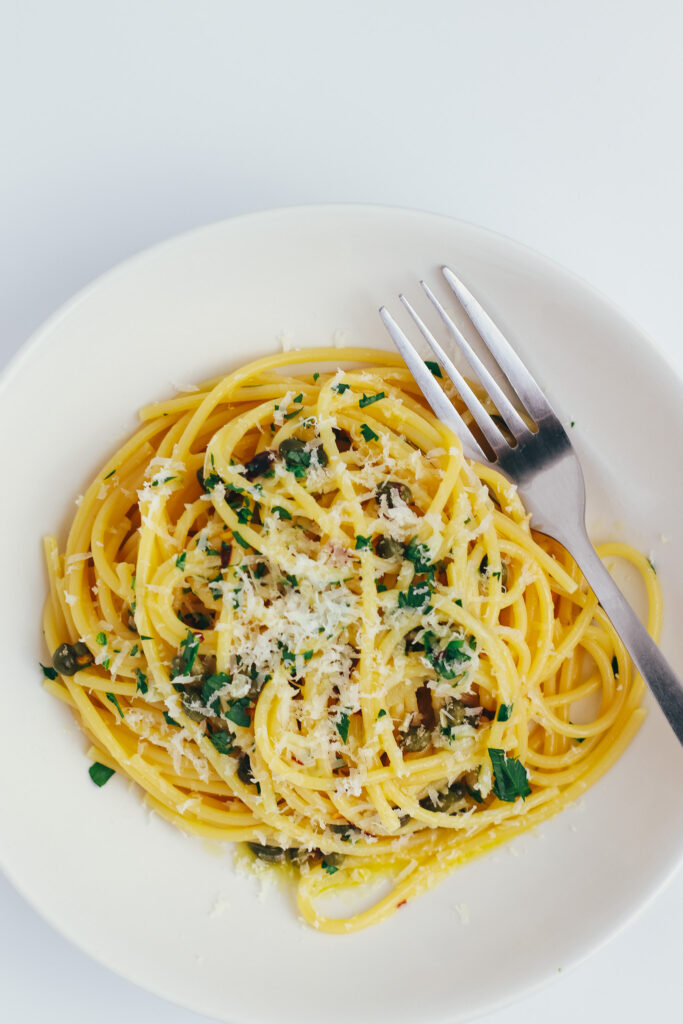
Top Tips For Pasta With Lemon and Capers
- Cook the pasta 2 minutes shy of being fully cooked. It will finish cooking in the frying pan as you toss with the pasta water to create your sauce.
- Use a large frying pan so you have enough room to toss the pasta with the sauce.
- Try adding a splash of white wine like sauvignon blanc to enhance the dish’s flavour profile and complement the acidic flavours of the capers. You could also add a little chicken broth/vegetable broth.
- Add some grilled chicken to make this an even more complete meal or pair with succulent sweet scallops or shrimp or serve with a simple side salad. Pair it up with chicken piccata!
- Try using different types of pasta, such as linguine or tagliatelle or angel hair. Any type of thin pasta will work well.
FAQ’s
Capers can add some extra flavour to your dish and can be added to sauces and condiments for some extra bite. They can also be a garnish and match well with fish and meats – think tartare sauce and tapenade.
You can try a couple of things. Adding a little butter or cream will help dull the lemon flavour. Another good trick is to add some sugar—sweetness has a great ability to cancel out acidity.
You are looking for something with the same salty, acidic flavour, so anchovies, green olives, or pickles can be good substitutes.
Capers are little nuggets of flavour! They taste almost lemony and a little like olives with a briny flavour. A lot of capers either come in brine or salt, and can have a very salty and savoury flavour.
Capers are little flower buds from the caper bush, the Flinders rose. They are either pickled or packed in salt and sold in jars to eat. They have a lovely tangy flavour profile and pair great with fish as well as chicken.
Capers pair up great with fish and chicken and can be used in a multitude of ways. Commonly used in sauces such as tartar sauce or gremolata they can also be added to dressings, salads, added for extra flavour to vegan/vegetarian dishes and they go great with seafood.
Easy Lemon Caper Pasta
Equipment
- 1 large frying pan
- 1 large saucepan
- 1 chefs knife
- 1 set of silicon tongs
- 1 grater
Ingredients
- 200 g dried spaghetti
- 2 cloves garlic
- 1/2 tsp dried chilli flakes
- 2 tsp nonpareille capers
- 1 lemon (juice of)
- 1 tbsp extra virgin olive oil
- 1 tbsp salted butter
- 1 tbsp chopped parsley
- grated parmesan
Instructions
- Begin by adding your pasta to well salted boiling water. Cook 1 minute short of cooking time – the pasta will finish cooking in the sauce.
- A few minutes before the pasta is done, melt the butter and olive oil over a medium high heat
- Add the garlic and saute for a minute
- Add the capers, the chilli flakes and cook for 30 seconds
- Add the pasta to the frying pan with a little pasta water (reserve some in a cup) and toss to help create an emulsified creamy sauce. Add more if needed.
- Add the parsley and lemon juice and toss again until combined
- Plate and finish with some fresh grated parmesan and ground black pepper
Try My Other Pasta Recipes

Hi, I’m Paul! I’m a passionate home chef, recipe developer, and food lover who believes that cooking should be fun, rewarding, and stress-free! Through Scoffs & Feasts, I share my favorite tried-and-tested recipes, cooking tips, and troubleshooting advice to help home cooks gain confidence in the kitchen. Whether you’re a beginner or an experienced foodie, I hope my recipes inspire you to try something new.

